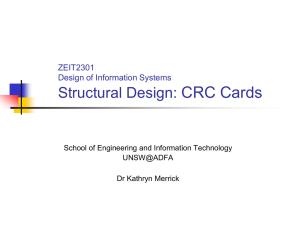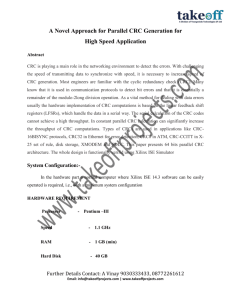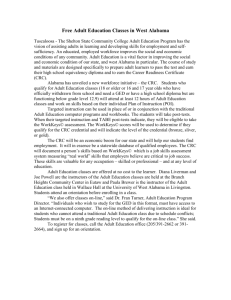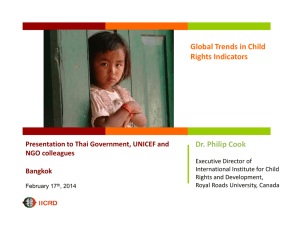Working practically with the CRC
advertisement
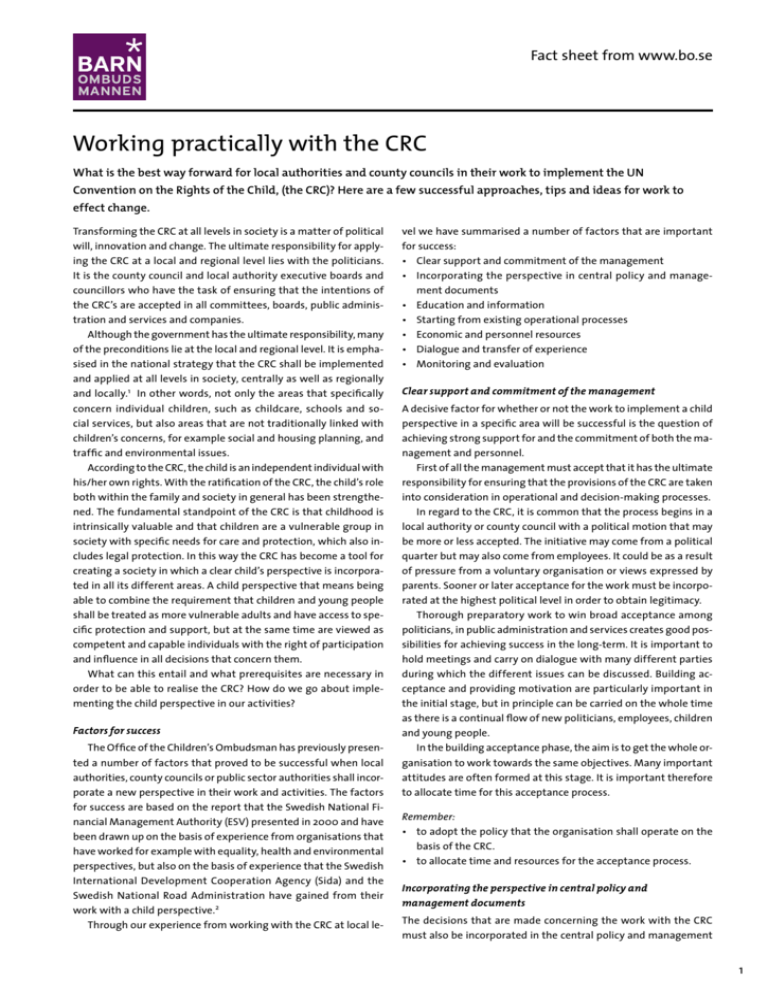
Fact sheet from www.bo.se Working practically with the CRC What is the best way forward for local authorities and county councils in their work to implement the UN Convention on the Rights of the Child, (the CRC)? Here are a few successful approaches, tips and ideas for work to effect change. Transforming the CRC at all levels in society is a matter of political will, innovation and change. The ultimate responsibility for applying the CRC at a local and regional level lies with the politicians. It is the county council and local authority executive boards and councillors who have the task of ensuring that the intentions of the CRC’s are accepted in all committees, boards, public administration and services and companies. Although the government has the ultimate responsibility, many of the preconditions lie at the local and regional level. It is emphasised in the national strategy that the CRC shall be implemented and applied at all levels in society, centrally as well as regionally and locally.1 In other words, not only the areas that specifically concern individual children, such as childcare, schools and social services, but also areas that are not traditionally linked with children’s concerns, for example social and housing planning, and traffic and environmental issues. According to the CRC, the child is an independent individual with his/her own rights. With the ratification of the CRC, the child’s role both within the family and society in general has been strengthened. The fundamental standpoint of the CRC is that childhood is intrinsically valuable and that children are a vulnerable group in society with specific needs for care and protection, which also includes legal protection. In this way the CRC has become a tool for creating a society in which a clear child’s perspective is incorporated in all its different areas. A child perspective that means being able to combine the requirement that children and young people shall be treated as more vulnerable adults and have access to specific protection and support, but at the same time are viewed as competent and capable individuals with the right of participation and influence in all decisions that concern them. What can this entail and what prerequisites are necessary in order to be able to realise the CRC? How do we go about implementing the child perspective in our activities? Factors for success The Office of the Children’s Ombudsman has previously presented a number of factors that proved to be successful when local authorities, county councils or public sector authorities shall incorporate a new perspective in their work and activities. The factors for success are based on the report that the Swedish National Financial Management Authority (ESV) presented in 2000 and have been drawn up on the basis of experience from organisations that have worked for example with equality, health and environmental perspectives, but also on the basis of experience that the Swedish International Development Cooperation Agency (Sida) and the Swedish National Road Administration have gained from their work with a child perspective.2 Through our experience from working with the CRC at local le- vel we have summarised a number of factors that are important for success: • Clear support and commitment of the management • Incorporating the perspective in central policy and management documents • Education and information • Starting from existing operational processes • Economic and personnel resources • Dialogue and transfer of experience • Monitoring and evaluation Clear support and commitment of the management A decisive factor for whether or not the work to implement a child perspective in a specific area will be successful is the question of achieving strong support for and the commitment of both the management and personnel. First of all the management must accept that it has the ultimate responsibility for ensuring that the provisions of the CRC are taken into consideration in operational and decision-making processes. In regard to the CRC, it is common that the process begins in a local authority or county council with a political motion that may be more or less accepted. The initiative may come from a political quarter but may also come from employees. It could be as a result of pressure from a voluntary organisation or views expressed by parents. Sooner or later acceptance for the work must be incorporated at the highest political level in order to obtain legitimacy. Thorough preparatory work to win broad acceptance among politicians, in public administration and services creates good possibilities for achieving success in the long-term. It is important to hold meetings and carry on dialogue with many different parties during which the different issues can be discussed. Building acceptance and providing motivation are particularly important in the initial stage, but in principle can be carried on the whole time as there is a continual flow of new politicians, employees, children and young people. In the building acceptance phase, the aim is to get the whole organisation to work towards the same objectives. Many important attitudes are often formed at this stage. It is important therefore to allocate time for this acceptance process. Remember: • to adopt the policy that the organisation shall operate on the basis of the CRC. • to allocate time and resources for the acceptance process. Incorporating the perspective in central policy and management documents The decisions that are made concerning the work with the CRC must also be incorporated in the central policy and management 1 Fact sheet from www.bo.se documents for the specific areas. This is part of the acceptance process. The work on formulating goals and objectives takes place at various levels within the organisation and is written in a variety of different documents. It is important to consider the overall objectives for children’s and young people’s policy on which consensus can be achieved and the ways in which these relate to legislation, to the CRC and to other existing policy and management documents. Charting children’s conditions is one way in which to obtain answers to fundamental questions that you should ask yourself both at the start of transformation work and repeatedly when the work is in progress. It is important to identify problems within the area in which you are working and to consider what needs to be changed. It is also necessary to find out which resources are available and how they can best be utilised. Methods of working must be decided and consideration must be given to the resources that are required, both personnel and financial, in order to attain the goals. It is important to allocate responsibility and to ensure cooperation with other parties concerned. Several key issues must be considered before we actually begin to convert the objectives into specific initiatives and plans of action: How should we proceed in order to achieve the objective? Which resources do we need? How will the work be financed? How must the work be organised and responsibility be allocated? How shall established plans and programmes be implemented? How should cooperation between the various parties be organised? Which tried and tested methods are suitable and which new methods need to be developed? Remember: • to state in the policy document for the area/activity that you shall work to implement the CRC. • to set up clear goals for the work. • to chart the current living conditions of children and young people locally or within specific areas and to use children and young people as a source of knowledge. • to also give children and young people the opportunity to give their opinion about the document. Education and information By disseminating information and educating employees, success can also be achieved. A basic precondition for the transformation work is that all employees are informed about the new objective. They should also have the opportunity to obtain factual knowledge about the history, content and legal status of the CRC. Employees should also understand what it means to have a child perspective in their own activities and their own decision-making processes. Without such an awareness, the work to integrate a child perspective will not feel natural. It is also important to ensure that all employees have the child competence that is required in order for them to carry out their work. By child competence we mean the professional competence in regard to children within our respective fields of work. This may be a question of formal competence in the form of education, job experience and similar, for example within paediatric surgery or child development. It could also be about intimate knowledge that has been acquired through working with children on a professional basis. Another component of child competence is the ability to communicate with children, young people and their guardians. 3 Remember: • that everyone needs to have information about the new objective. • that information specifically adapted for children and young people should be available. • to draw up a specific education plan in regard to knowledge about the CRC and how it can be realised in the employees’ own work. • to draw up an education plan for maintaining the necessary level of child competence. Does for example everyone who interviews children and young people have the essential knowledge and skills? Starting from existing operational processes By starting on the basis of already existing operational processes, when beginning to work with an additional perspective, the organisation utilises the resources it already has. Also, it reduces the stress on the organisation and on the individual employee. Remember: • to identify which decision-making processes concern children and young people. • to ensure that children’s and young people’s opportunity to exert influence is included as an element in the decision-making process. • to ensure that documentation of children’s and young people’s views is included as an element in the decision-making process. • to ensure that the reasons for the decision are documented together with the consequences that the decision may have for children and young people. • to ensure that decisions are communicated back to children and young people. Economic and personnel resources Starting to work from a new perspective can entail both major and minor changes depending on the type of activity concerned. These changes may also entail costs, for example for personnel. Irrespective of the degree of change it is important to give the employees time in which to develop their work to encompass the new perspective. 2 Fact sheet from www.bo.se Remember: • to allocate resources for a coordinator in order to get the work started. • to allocate resources for competence development. • to allocate resources for developing a child perspective in the existing operational processes. Dialogue and transfer of experience Dialogue and the transfer of experience are important both within the organisation and between different organisations. By discussing experience you learn from each other and avoid having to make the same mistakes, at the same time as the subject is kept topical and the risk that the perspective will be forgotten is reduced. It is also important to cooperate and to have an overall view in the work with the CRC. The work can be made more effective in many instances through cooperation. Cooperation should be based on children’s needs and an overall perspective of the child. Remember: • that the work with the child perspective shall be a recurring item at internal meetings. • to organise specific meetings for sharing experience among different committees, public administrations, local authorities, county councils and county administrative boards and ensure that local authorities are able to share experience with county councils and county administrative boards. • to find forms of cooperation that are based on an overall perspective of the child. In December 2005, an education day was held for county councillors in regard to children’s rights issues. This focused on influence and participation and the child’s perspective in decision making. Representatives from the county council and a number of local authorities are involved in a project under the auspices of the foundation Allmänna Barnhuset. The Office of the Children’s Ombudsman is also following the project in which the participants are discussing how one can obtain qualitative and economic benefits in the long-term through cooperation and preventative work. Monitoring and evaluation Monitoring and evaluation indicate how the child perspective has been taken into consideration and the effects that the decision has actually brought about. It is an important element when formulating new goals and operational methods. Organisations that work well are already today carrying out monitoring and evaluation in order to obtain knowledge about the effects that the decision has had for children and young people. Remember: • to incorporate a child perspective in the auditing work. • to draw up a specific children’s “balance sheet”. Incorporating a new perspective Establishing a new perspective in regard to decisions and activities is nothing new in Swedish public administration. In the 1990s, lo- cal authorities, county councils and government authorities have been called on to take special consideration of the consequences for the environment, health and equality. Their activities shall be permeated by a certain perspective in operational and decisionmaking processes at all levels and in all fields. The development work shall be carried out by the ordinary staff within an organisation and be included as a natural part of all activities. Understanding, being able to and wanting to Introducing a new perspective can also be described on the basis that the person applying the perspective must want to, understand and be able to implement the decision. In order that the new approach shall be accepted in operational processes and decisions, the personal responsibility for all employees in achieving this must also be emphasised. It is required of each individual who shall organise, apply and implement the CRC in practice that they have a strong and long-lasting commitment to the task. An individual who is involved in the work with the CRC must understand, want and be able to implement it. It is important to really want to be involved in its implementation. “Understanding” means that one understands the significance of the reform through knowledge of its objective. A reasonable assumption is that commitment increases if one has understood the significance of the work with the CRC. “Being able to” means that each individual employee is given the opportunity to work with the perspective. Conflicts and opposition Not everyone always agrees that new methods of working are necessary and there is often scepticism towards seeing the CRC as a practical tool in the transformation efforts. Of course both conflicts and opposition emerge in conversations and discussions about what the CRC means and how it shall be applied. Advancing arguments, handling and discussing conflicts and opposing views are inescapable and necessary ingredients in all work to effect change. Resistance can sometimes, paradoxically enough, play a role in driving development forward. If other people and interests do no impose requirements and proffer opposition, there is a risk that the development will stop or that the work becomes too superficial. It is necessary to be forced to reflect and argue one’s case. Changing one’s routines and methods of working always involve a lot of effort and quite a lot of moaning and groaning too, but do not forget that the purpose is to improve the work! Learning from experience In reality we rarely work as rationally as we describe it in theory. ”Change work” is often about carrying out several different tasks at the same time and the work can be started and carried on in many different ways. Different processes interact and overlap with each other and the work can be started almost at any point in the process. The work to incorporate a new perspective is characterised by the learning that takes place through trial and error, and obtaining 3 Fact sheet from www.bo.se specific experience of how to deal with different problems and which tools are most effective in order to bring about change. The learning takes place in dialogue between people; between politicians and employees, between educationalists and engineers, professionals and voluntary workers, between children, young people and adults. ”It is in the meeting that change takes place, after that you can produce as much paper as you want.” This is the comment from a local authority employee as he reflects over what is important in order to bring about change. There is no clear recipe to give, and knowledge about the CRC and its application must be continually updated. Dialogue is a prerequisite for the democratic processes. Discussion between people makes it possible for confidence to grow forth in society and the belief can increase in one’s own opportunities to have an influence. Discussions form the soil in “the democratic nursery”. The process as such, the road to joint decision-making and points of view is particularly valuable. 4 Sharing experience, desire and delight Those who work with change and are faced with new major tasks often feel a strong immediate need to know what to do. It is often the case that you feel that other people are doing so much better and you hope to find the right model or right method that can provide guidance on how to proceed. Sharing experience among local authorities, county councils and organisations can be fruitful in many ways. A new perspective can be gained by looking at one’s own work in relation to others. It may just be that the major benefits are to be found in this sharing of experience. Of course it is possible to benefit from specific tips and ideas, but it is not certain that the method of approach that has worked so well in the neighbouring local authority will work just as well in your local authority. The local circumstances often vary a great deal. Desire, delight and creativity are other elements that can take things a long way in the work to effect change. But that alone is not sufficient. An employee reflected about why the committed CRC group in the local authority was not having much success in gaining acceptance for its ideas and proposals at the highest political level: ”We have been naive. Enthusiasm alone is not enough.” Both self-criticism and self-confidence are important elements in the work. A prerequisite for being able to build self-confidence is that knowledge and experience is able to develop as an element of everyday work. At the same time, self-criticism is an important precondition for review and continued learning. Own values and attitudes In order to meet the CRC’s requirements, we need sometimes to change our attitudes and approaches. The CRC provides an important value platform where article 3 about the child’s best is the fundamental ethical and moral principle. Those of us who are working with the CRC as a value platform cannot just talk about children or acting on behalf of children, we must also plan and carry out the work together with children and young people. It is a question of finding out where, when, how and in which issues children and young people can take part. It is also important to consider the way in which we give children and young people the opportunity to have an input and take part. We should be aware of two different approaches in regard to children. On the one hand we should look at the requirement of children and young people for care and protection, and on the other hand we should view children and young people as competent individuals and give them the opportunity to be involved as active parties. People working to effect change need therefore to have the ability to make wise evaluations and to act in an ethical manner with respect for people’s equal value, the freedom and integrity of the individual, solidarity with weak and vulnerable groups, tolerance and willingness to assume responsibility. Notes 1 Prop. 1997/98: 182. 2 Ekonomistyrningsverket. Barnperspective vid statliga beslut. Dnr:75-701/1999. 3 Regeringskansliet. Mötet med barnet – barnkompetens inom hälso- and sjukvården. Karlskrona, 2005. 4 Theodorsson, A. Föräldrakooperativa förskolor som demokratiska plantskolor, 1999, i Det unga folkstyret. SOU 1999:93.


